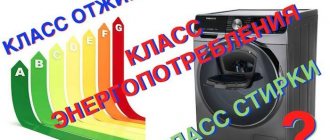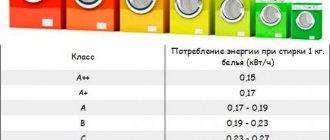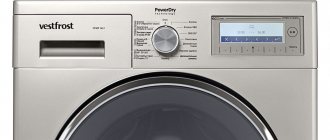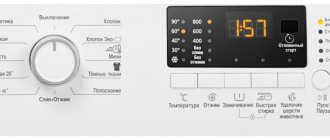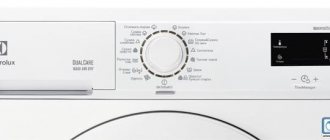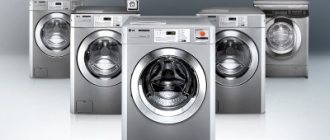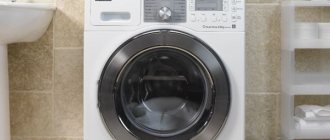What determines the energy consumption of devices?
The basic rule is this: the more powerful the device and the longer it operates, the more electricity it consumes.
For example, an LCD TV with a power of 0.2 kW will consume as much energy in six hours of operation as a heater with a power of 1.2 kW in an hour.
The energy consumption of devices depends, of course, on the operating mode: a computer in standby mode “eats” about 25 times less than in operating mode. And a breather with the heater turned off is more than 40 times smaller than with it turned on at full power.
Look for information about the power consumption of a particular device in the instruction manual and on the sticker on the back of the device itself. The manufacturer may indicate a range of power consumption, or may indicate only the maximum. We do not recommend focusing on the maximum: the actual operation of equipment usually does not require such sacrifices. Let's say, the maximum power consumption of a breather, 1.45 kW, is necessary only when the device must heat air at a temperature of -40°C to +25°C - i.e. at 65°C! Even in harsh Siberia, such cases are extremely rare (we know from our own experience ).
Below is a table of the capacities of various devices. The figures are approximate, but are suitable for orientation and comparison.
How to calculate the energy consumption of devices
To calculate the energy consumption of a stove, TV or any other device for a month, you need to multiply its power consumption (in kW) by the time it operates. Let's take the same TV with a power of 0.2 kW. If it works on average 3 hours a day every day, then its energy consumption per month will be about
0.2 kW x 3 hours x 30 days = 18 kWh.
To calculate electricity costs, multiply the resulting number by the cost of 1 kWh according to the tariff of your region.
Below are the hypothetical average monthly energy consumption of some common household appliances. For climate control equipment (breather, air conditioner), the energy consumption of which strongly depends on the ambient temperature, the average figure for the year was taken.
A little history
Labeling the energy consumption class of a product has been used in Europe since the 90s of the 19th century. Now the label is used in more than 50 countries around the world. Mandatory energy efficiency labeling has become a key tool for efficient energy consumption and a driving force for reducing the energy intensity of the gross national product.
In practice, there are now two energy efficiency labeling systems:
- The American Energy Guide model, which involves analyzing the energy consumption of similar products and selecting from them about 25% with the lowest energy consumption, which are assigned the Energy Guide brand
- The labeling model adopted in the EU countries, which involves dividing all products of the same type into seven classes, from A to G. The same designations apply in Russia. The division is made according to the ranges of quantitative indicators of energy efficiency throughout the entire range of characteristics from the most economical to the most energy-wasting
The main levers of influence of energy efficiency labeling on the energy intensity of the economy include:
- restrictions on the export of energy-intensive products (the import of products of classes F and G into the EU countries is prohibited, and temporary restrictions have been introduced on the middle classes D and F)
- linking energy efficiency with carbon dioxide emissions into the atmosphere, implying the inclusion of labeling in the system of sales of air emission quotas
- a system of fiscal measures to limit the production and sale of energy wasteful equipment
- state support for those enterprises that are focused on using energy-efficient goods in the production
- discounts for consumers choosing energy efficient technologies
- promotion of energy saving and respect for the environment
Refrigerator energy consumption
Modern refrigerators are required to be labeled indicating the energy consumption class. There are only seven classes: A, B, C, D, E, F, G, but refrigerators of classes D, E, F, G are not currently produced - they are outdated and not at all economical.
Each class corresponds to a certain energy efficiency index.
Refrigerators
What do these numbers mean? If you take a certain average value of energy consumed by a refrigerator (calculated empirically), then the energy efficiency index indicates what proportion of this average value a particular refrigerator consumes.
For example, the energy consumption class of a refrigerator A corresponds to the index 42–55. This means that a class A refrigerator consumes no more than 42–55% of the average energy consumption. Typically, manufacturers place a sticker on the refrigerator, which, in addition to the actual energy consumption class, indicates the hypothetical consumption in kWh we are accustomed to. It's better to focus on these numbers.
Which is better
The optimal energy efficiency class for a refrigerator is A: its index does not exceed 55%. This also includes subclasses A+ and A++, which are considered highly efficient: A+ spends up to 42% of energy when properly installed, A++ no more than 30%.
Models of the highest class A+++ are almost always single-chamber refrigerators or separate freezers. Their high price is not offset by years of energy savings.
Classes A++ and A+ are optimal in terms of energy efficiency and are represented by models starting at RUB 45,000. Energy consumption indicator is at least 315 kW/h per year.
Refrigerators of category A are most often single-chamber, so the price is low, on average from 19,000 rubles. Energy consumption per year will be from 360 kW/h.
Class B models are also considered economical, although they are less efficient than A. They are successful in the market due to their price-quality ratio. The energy efficiency index ranges from 55 to 75%. Two-chamber refrigerators with a volume of 275 liters cost from 20,000 rubles.
C is the lowest of the classes included in the “TOP” energy efficiency. Significantly inferior to A and B, but remains within the normal range of 100%: the index ranges from 75 to 95%. One of the advantages is the budget price, about 10,000 rubles. The downside is that at least 548 kW/h of energy is spent per year.
Models marked D are less common, since they differ in their position on the border of average energy efficiency: from 95 to 110%. Manufacturers of household refrigerators are reducing production of units in this category. According to forecasts, in 5-10 years they will finally be removed from the assembly line.
Refrigerators with a class below D are considered inefficient and have not been found on the household goods market for the last 15-20 years.
Interesting! In the Russian Federation, the new classification has turned into a marketing ploy: prices for ultra-efficient foreign-made refrigerators of class A+++ are 30-35% higher than for models of the same category sold in Europe.
The amount of energy that equipment will consume depends not only on the category, but also on the volume. For example, a refrigerator model Bosch KAN 58A40 class “A” with a volume of 507 liters will consume 522 kW/h of electricity per year, and a copy of the same category “A” Ariston MBA2200 with a volume of 370 liters will consume only 360 kW/h. A large refrigerator will increasingly consume more light, although it is labeled with a high energy efficiency class.
Washing machine energy consumption
A washing machine is one of the most powerful household appliances. It has an electric motor, a heating element, and a pump - all this requires energy.
As in the case of refrigerators, washing machines are labeled with one or another energy consumption class. How is it calculated? The standard is taken to be a full cycle of washing cotton laundry at a temperature of 60°C. A class A washing machine without a drying function will spend no more than 0.19 kWh per kilogram of laundry, and a class B washing machine will spend from 0.19 to 0.23 kWh.
Next to the energy efficiency class you will find an indication of the energy consumption of your washing machine per wash cycle.
Energy efficiency
Of course, the figures given are approximate. In real conditions, the energy consumption of a washing machine will depend on the washing mode and temperature, the amount of laundry, and its composition.
Spin class
Spin quality is characterized by the percentage of moisture remaining in the laundry after washing, which directly depends on how many revolutions per minute the machine makes. In other words, the more revolutions per minute it makes, the drier the laundry becomes. The percentage of residual moisture is determined as the ratio of the weight of dry laundry before washing to its weight, but after the washing process. Washing machines are also divided into spin classes from A to G, and each class has its own residual moisture percentage and speed.
Computer power consumption
The most power-hungry parts of a computer are the processor, video card and monitor. On average, the power of a computer is 200-500 W. The most powerful computers are required by gamers, designers, planners, and if you are using a simple “workhorse”, then focus on the first number. When calculating, keep in mind that the computer usually works for several hours a day.
Laptops consume less on average, simply because they are usually not as powerful as desktop computers. The power of typical laptops is around 40–150 watts.
Energy consumption of climate control equipment
Energy consumption of climate control equipment has a pronounced seasonality. For example, many people use air conditioning exclusively for cooling during the warm season. In this case, air conditioning costs will be several times higher in summer than in winter.
An air conditioner is one of the most powerful household appliances and, of course, if it is constantly on, the energy consumption will be significant.
The energy consumption of a breather also greatly depends on the time of year, or more precisely on whether it needs to heat the air or not. Heating elements of any equipment always require a lot of energy (look at a kettle, hair dryer, heater). Therefore, in winter, the energy consumption of the breather increases. Let's say, in conditions of -25°C outside the window, the breather will need a power of about 400 W to heat the incoming air to +10°C (at first speed), and about 520 W to heat it to +20°C.
But in the warm season (and some turn off the heating in the breather as soon as the temperature outside stops dropping below zero), the breather requires only 30 W at first speed to operate. Even if the device works around the clock, it will only cost 21.6 kWh per month.
When calculating the costs of climate control equipment, it would be correct to take into account not the minimum and not the maximum, but the average annual energy consumption.
In this video, the user shares his experience of using the breather and indicates real energy consumption figures:
Manufacturers of the most energy-saving models
Today, domestic consumers are most in demand for refrigeration equipment with energy consumption classes A, A+, A++, A+++. The leaders in the production of such equipment are foreign brands Siemens, Liebherr, Bosch, LG, Samsung, Whirlpool. In the budget segment, one can highlight energy-efficient equipment produced under the brands Nord, Ariston, Indesit and Atlant.
Examples of refrigerators
What refrigerator size should I choose?
For an ordinary family of four, a refrigerator with a capacity of 320/360 liters is sufficient. Keep your requirement in mind before purchasing the appliance. Although three door refrigerators look modern and create good home decor, their efficiency is much lower than single door or double door refrigerators. Large refrigerators, which contain almost no items, require more energy to maintain a certain temperature than small ones, which are stored at full capacity.
Although the structure and shape of a refrigerator does not directly affect its efficiency, it is important for saving energy. Refrigerators with top and bottom doors are considered more energy efficient than refrigerators with parallel doors. This is due to the placement of the compressor, which plays an important role in its efficiency.
Let's sum it up
As it turns out, the energy consumption of a refrigerator is an important indicator of budget savings, since the device operates around the clock, 365 days a year and can charge a significant amount for electricity. Therefore, we have presented the most common refrigerator models, which are affordable and functional. Which one is better is up to you to choose.
Sources
- https://make-a-choice.ru/chto-takoe-klass-energopotrebleniya-holodilnika/
- https://stroytvoydom.ru/interesnoe-vazhno-znat/to-takoe-klass-energopotreblenie-holodilnikov/
- https://tehnikoved.ru/kuhnya/holodilnik/chto-takoe-klass-energopotrebleniya-holodilnika.html
- https://oholodilnike.ru/vybor/kakoj-klass-energopotrebleniya-luchshe.html
- https://holodik.ru/articles/klass-energopotrebleniya-holodilnika
- https://PoiskTehniki.ru/tehnika-dlja-kuhni/klassy-jenergopotreblenija-holodilnikov-chto-jeto-takoe-i-kakoj-klass-vybrat
- https://tehnika.vyborkuhni.ru/vybrat-holodilnik/klass-energopotrebleniya-holodilnika
[collapse]
